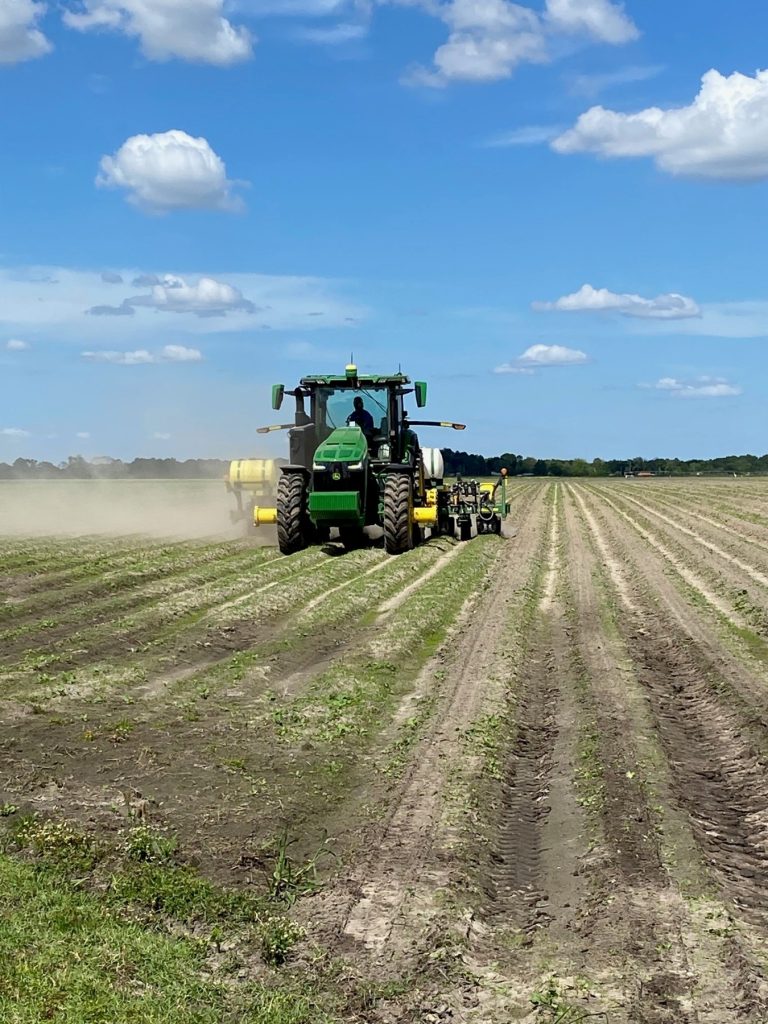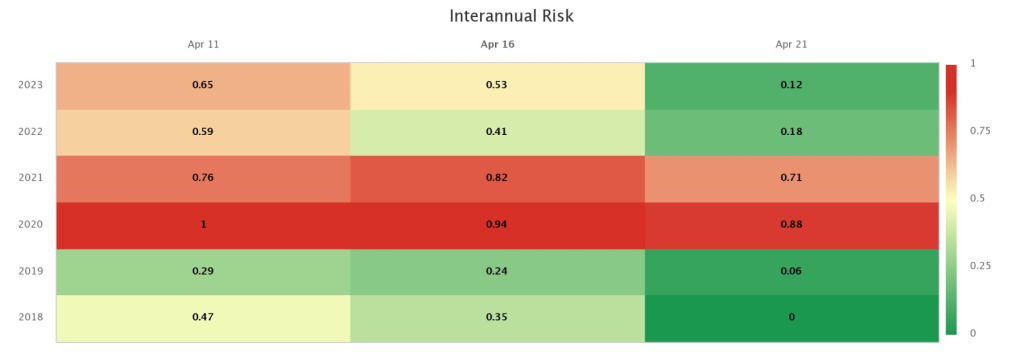It has been another interesting week in Colquitt County agriculture. Area growers are applying cotton burndown, and preparing for the peanut crop. The area corn crop ranges from just planted to V3. The wheat crop ranges ranges from late boot stage to soft dough.
We planted 2 locations of on farm corn variety plots this week. We are going to evaluate 16 hybrids this year from Agratech, Croplan, Dekalb, DynaGro, Pioneer, and Northrup King. Thank you to those industry partners in this project.

Peanut Pointers (Scott Monfort) I have received several calls over the last few weeks regarding varieties. There a few key things to remember.
First, a majority of the acres will still be GA-06G. Other varieties with some acres will be GA12Y, GA-16HO,
GA-18RU, GA-20VHO, TifNV-High OL, AUNPL-17, & FloRun 331 (See figure below). There are seed
increase acres out there this year for GA-21GR, TifNV-HG, and GA 22MPR. With this said, remind your
growers that if they want to plant in April they need to look over the Peanut RX and do everything they can to minimize TSWV. There are only a couple of varieties with higher levels of resistance to TSWV compared to GA-06G: which includes GA-12Y and TifNV-High OL. We are hopeful the new varieties will provide some better resistance to TSWV. We will know more after this season. At this point all we can do is uses planting date, insecticide, row configuration, plant populations and tillage along with the current variety options available to minimize the impact of TSWV. I understand growers cannot adhere to all of the recommended cultural practices. We just want them to consider the recommendations and modify the practices as needed for their operation.
Along with these practices, growers also need to pay attention to seed quality and environmental conditions as they can affect final stand. The main thing of concern this year regarding seed quality is the potential reduction in seed vigor due to quality issues last year. Low seed vigor alone can cause slower plant emergence and/or skippy stands resulting in an increased risk of TSWV infection. However, if couple lower seed vigor, subpar environmental conditions, and planting in the high-risk window (April-May 10), you will have a perfect storm for having a high level of TSWV Infection and potentially a loss in yield potential.

Variety Information
• Georgia-12Y
• Plant before May 12
• Manage vines
• Manage Rhizoctonia Limb Rot
• Ga-18RU
• Higher susceptibility to TSWV compared to GA-06G
• Do not plant before May 10 th
• Leafspot late in season can be an issue
• GA-16HO
• leafspot late in season can be an issue
• GA-20VHO
• High Risk to shed pods in prolonged periods of excessive moisture late in season,
only plant in well-drained fields!
• TifNV-HG
• Root-knot resistant
• Similar to GA-06G in yield potential
• Ga-21GR and GA-22MPR
• These two varieties are new and we have little information available
• GA-21GR has potential for higher grades and medium to large seed size
• GA-22MPR is a high oleic RKN resistant variety and is medium to large seed size
Mr. Kichler, is it too early to plant cotton? This has been a topic of discussion with area growers. The weather forecast for the up coming week has highs in mid 80s and lows in the 50s.

Some of the information below was taken from the article Keeping Early Season Planting Considerations Simple (John Snider, Camp Hand, Josh Lee) from the April 2023 UGA Cotton Team newsletter.
Cotton doesn’t like it when it’s cold, so plant when it’s warm.
• How cold is too cold for cotton? Chilling temperatures are less than 50 °F but above freezing. These
temperatures can kill or severely injury a developing seedling if experienced during early germination
and will slow plant growth more than predicted by DD60 accumulation when experienced after
emergence. Check the forecast for your region prior to planting.
• What are ideal temperature conditions for planting? The current recommendation is for planting
to occur when soil temperatures are 65 °F or above for three consecutive days and when 50 DD60s are
projected to accumulate within five days after planting. These conditions are conducive to rapid
germination and vigorous seedling growth, which has the added benefit of decreasing the damage that
can be done by early season pests.
Below are the 2, 4, and 8 inch soil temperatures for the last 7 days (April 9-April 15, 2023) from the UGA Weather Station at the Sunbelt Ag Expo.

• What’s a DD60? This is the number of degree days accumulated over a particular period of time. The
most simplistic formula for calculating daily DD60s is as follows:
DD60 = [(Tmax + Tmin)/2] – 60 °F
Other approaches to DD60 calculation also set an upper temperature threshold or a daily limit of 10
DD60s. DD60 calculators are available at http://www.georgiaweather.net/
Too much or too little water limits stand establishment.
• Too much water? I’m talking about water logging here. Oxygen is a requirement for growth during
the germination phase, so water logging suffocates plants by creating anaerobic conditions. Having a
well-aerated seed bed and avoiding excessively wet soil conditions via proper planting date selection
and knowledge of field history can help lessen these problems.
• Too little water? The cotton seed contains a desiccated embryo that is ~8-10% moisture, which is
substantially drier than other tissues on a fully-grown cotton plant (80-90% relative water content for
leaves). As a result, the cotton seed readily takes up water from the surrounding soil even if the water
content of the soil is low. This can be problematic if the soil profile has a relatively low soil water
content at planting because the seed is more susceptible to dehydration stress after embryonic tissues
have been hydrated. Obvious remedies for this situation include post-planting irrigation for fields in
which irrigation is available or planting into good soil moisture for dryland fields and knocking beds
down at planting to minimize water loss from the upper portion of the soil profile before harvest.
Planting depth affects moisture availability too. The current recommendation in Georgia is to plant
seed at a 0.5 to 1 inch depth. Deeper planted seeds have access to more soil moisture, but risk of stand
loss increases with depth, so planting a variety with high seedling vigor may be necessary in these
instances.
If you’ve got crusting, get a rotary hoe soon.
• What is crusting? I’m sure just about everyone reading this knows what crusting is, but rather than
assume too much, I’ll explain here. Crusting is when a thin compacted soil layer forms over a field.
The reason this is a problem is because the cotton seedling often cannot exert enough pressure to
break through the crust. If this crust isn’t broken up in time, the grower may be looking at a replant
situation.
• When should a rotary hoe be used? A rotary hoe would only be used where crusting was a
widespread issue in the field, but timing matters. As a general rule, a rotary hoe should be run within
10 days after planting to ensure that plants don’t just sit under the soil surface and rot. However, I
have also had good luck using a rotary hoe as late as 15 days after planting, provided the seedlings I
dug up exhibited normal development (a well-developed seedling radicle, pronounced hypocotyl
hook, and no visual evidence of disease). The best thing to do is dig up some plants and see what
you’re dealing with before making the decision to use a rotary hoe.
Make sure your planting equipment is fully functional and ready for planting.
• What should be done? Ensure that all parts of the planter are in good working order. It’s best not to
waste time and investment in cotton seed just to find out there was a planter problem after a field has
been planted. Dr. Virk has provided guidelines to ensure that your planters are ready for the season.
Read his article and prepare equipment accordingly. Incorrect planter setup can lead to 1) poor seed to
soil contact, which could limit imbibition and germination and 2) inaccurate depth settings which
could result in embryo dehydration if planted too shallow or inability of the seedling to reach the
surface if planted too deep.
NC State Extension has a great resource for cotton growers called the Cotton Planting Conditions Calculator. According to NC State Extension, The purpose of the Cotton Planting Conditions Calculator is to provide decision support for cotton planting. The tool obtains observed temperature and precipitation for the current day, plus forecasted temperature and precipitation data for the next 7 days for the user-selected location. Observed data is obtained from NOAA’s Real Time Mesoscale Analysis. Forecast data comes from the National Weather Service’s National Digital Forecast Database.
Temperatures are used to calculate base-60 degree days for each forecast day, and these are subsequently summed for 5-day moving windows. Cotton planting guidance is based on how many accumulated degree days are expected over a given 5-day period. Temperature and precipitation forecasts are also used to provide additional guidance on anticipated conditions, such as cool temperatures or saturated soils.

I ran the calculator for the Moultrie, Georgia, area for the upcoming week (April 16, 2023). The first table below shows the 5-day DD60 forecast if you planted on April 16 or 17, 2023. The second table shows the 7-day forecast from the National Weather Service and the DD-60s accumulated each day for the period from April 16–22, 2023.


The Thrips Infestation Predictor for Cotton is a web-based tool with predicts the risk from thrips by location and planting date. Below are results from this model for a April 16th planting date in Moultrie, GA. The Thrips Infestation Predictor for Cotton uses weather data to make predictions of (1) thrips dispersal timing, (2) Cotton growth affecting seedling susceptibility, and (3) injury risk that results from thrips dispersal and seedling susceptibility occurring at the same time.


According to the this tool, the predicted risk of thrips injury for the selected location compared across planting dates within the current 2023 season. Because the scale is normalized within the current year, the predicted risk for a series of potential planting dates ranges from least (dark green) to highest (dark red), regardless of whether the current year’s risk is high or low relative to prior years. By considering the relative risk predictions displayed in this figure and the risk predictions over the current and prior five years displayed in the preceding figure, the current years risk predictions can be placed in the context of the preceding five years. Specific planting dates are displayed by dragging the pointer across the figure. The arrow on the vertical scale at the right points to the predicted risk for the selected date. Predicted risk is based on predicted weather, for dates in the future. An abrupt change in weather (for example a cold snap) will change the predictions appreciably.
If you have questions or comments please contact your local county Extension agent.
Have a great week,
Jeremy M. Kichler
Colquitt County Extension agent.
